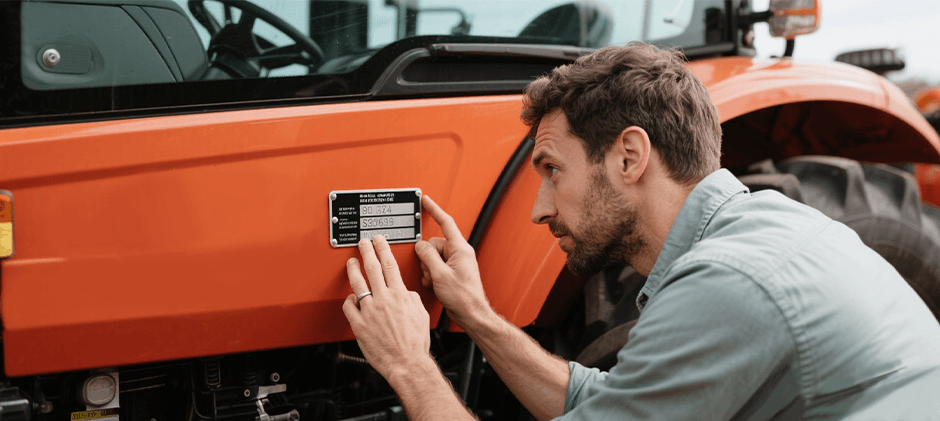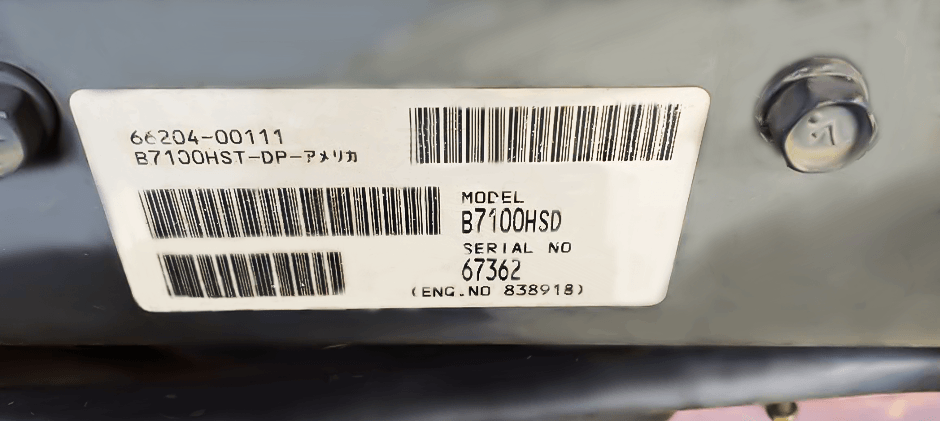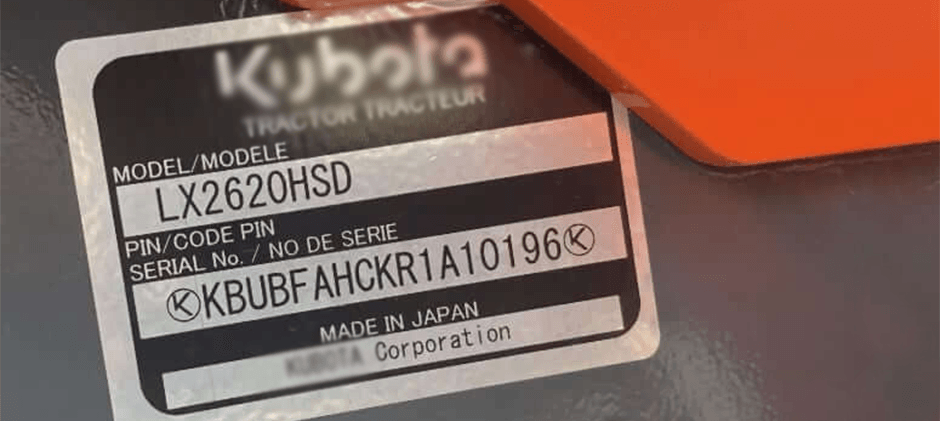When you’re ready to order parts for your Kubota tractor or sell the entire unit, the inevitable question is: What year is the tractor? Unlike road vehicles, the year of a tractor isn’t always straightforward to find; it usually requires deciphering the serial number. However, decoding this number isn’t always easy. Kubota has used different serial number systems over the years, and understanding which system your machine uses is crucial. This guide will show you where to find your serial number, explain the differences between old and new formats, and help you perform a Kubota serial number lookup to reveal the year and other important details about your machine.
Why Does the Year of the Tractor Matter?
Before we get into the “how,” let’s quickly cover the “why.” Knowing the precise manufacturing year and production details of your tractor is crucial for several reasons:
- Parts Compatibility: This is the most important reason. A model like the L3901 might have slight changes in its engine or hydraulic components from one production run to the next. Knowing your tractor’s specific year ensures you order the correct Kubota tractor parts, like a water pump or alternator, that will fit and function perfectly.
- Maintenance Schedules: Service recommendations can change over a model’s lifespan. Knowing the year helps you follow the correct maintenance schedule for fluids, filters, and inspections.
- Resale Value: The age of a tractor is a primary factor in determining its market value. Being able to prove the manufacturing date gives both buyers and sellers confidence in the transaction.
- Technical Information: Knowing the year helps you find the correct operator’s manual and technical specifications, ensuring you operate the machine safely and effectively.

Where to Find the Serial Number on a Kubota Tractor?
First, you need to locate the number. While the exact spot can vary by model series, Kubota typically places the serial number plate or stamping in a few common areas. If you’re unsure where to begin, always start your search on the right-hand side of the tractor, as this is a frequent location for many models.
To make your search easier, here are the most common locations for the popular Kubota series:
- BX Series: Check the frame rail, specifically above the right-hand front wheel.
- B Series: Look on the right-hand side of the front axle.
- L Series: Common spots include the left-hand side of the front axle or on the frame under the operator’s seat.
- Grand L Series: Typically found on the left-hand side of the front axle or on the right-hand side of the transmission case.
- M Series: Generally located on the left-hand side of the frame, below the engine and near the main factory tag.
You will find the number in one of two forms: a printed silver or black sticker, and a number physically stamped directly into the metal frame. The stamped number is the permanent one; the sticker can sometimes peel off over time. You can take a photo to keep as a record to prevent the loss of the serial number in case it is needed.
How to Determine the Year of a Tractor by Serial Number?
This is the core of our guide, and it’s where we must address a major change in how Kubota identifies its machines. There are two systems: the traditional 5-digit serial number and the modern 17-digit Vehicle Identification Number (VIN).
The Old System: Model + 5-Digit Serial Number
For decades, Kubota used a simple system. You had the model number (e.g., B7100HSD) and a 5-digit serial number (e.g., 67362).

With this older system, the 5-digit serial number itself does not directly encode the year. It is simply a sequential production number. To find the year, you must use the model number combined with the serial number and compare it against a model-specific reference chart. For instance, using our example B7100HSD with serial number 67362, we would look for a chart for the B7100 series. By checking a reference chart (like the sample one below), we can see that the number 67362 falls within the range for a specific production year, which in this case would be 1985. These charts can often be found through dealer resources or dedicated online forums.
For older tractors with a 5-digit number, you will need a model-specific chart. Here is a sample for a popular older series to illustrate the concept:
Sample Chart: B7100 Series
| Serial Number Range | Year of Manufacture |
|---|---|
| 10001 – 25380 | 1983 |
| 25381 – 64131 | 1984 |
| 64132 – 75831 | 1985 |
Disclaimer: This is an example only. You must find a chart specific to your model for an accurate year.
The New System: Decoding the 17-Digit VIN
More recently, Kubota transitioned to a modern, 17-digit VIN system, similar to what is used in the automotive industry. This number is packed with information, including the exact month and year of manufacture. If your tractor has a 17-digit number, you can decode it yourself.
Let’s use a real-world example of a modern Kubota tractor serial number and break it down piece by piece: KBUBFAHCKR1A10196

Digits 1-3: World Manufacturer Identifier (e.g., KBU)
- This identifies the business unit or engineering group. KBU is a common identifier for Kubota’s compact tractor division.
Digits 4-8: Machine Descriptor Section (e.g., BFAHC)
- Digit 4 (e.g., B): This indicates the product line. It’s an internal code, but in this case, it likely refers to the B Series family.
- Digit 5 (e.g., F): This is a series indicator, showing a specific version or update of a model over its production life.
- Digit 6 (e.g., A): This is an internal reference to the engine’s horsepower range or specific configuration.
- Digit 7 (e.g., H): This tells you the transmission type. ‘H’ almost universally stands for a Hydrostatic (HST) transmission.
- Digit 8 (e.g., C): This indicates the operator station. ‘C’ signifies a full factory Cab, whereas an ‘R’ would indicate a ROPS (Roll-Over Protective Structure) model.
Digit 9: The Check Sum (e.g., K)
- This is a special digit generated by a mathematical formula based on all other digits. Its purpose is to verify that the VIN is valid and has not been transcribed incorrectly. It holds no other meaning for the owner.
Digits 10-12: Manufacturing Information (e.g., R1A)
- Digit 10 (e.g., R): THIS IS THE YEAR CODE. This is the direct answer to “What year is my tractor?” Looking at the chart below, ‘R’ corresponds to the year 2024.
- Digit 11 (e.g., 1): This is the factory code, an internal identifier for the specific plant where the tractor was assembled.
- Digit 12 (e.g., A): This is the month code, an internal identifier for the month of production.
Digits 13-17: The Sequential Serial Number (e.g., 10196)
- This is the same 5-digit sequential number used in the old system. It shows that this was the 10,196th unit of this specific model configuration to be produced.
For tractors with the modern 17-digit VIN, you can determine the year of manufacture by looking at the 10th digit.
| 10th Digit | Year | 10th Digit | Year |
|---|---|---|---|
| G | 2016 | N | 2022 |
| H | 2017 | P | 2023 |
| J | 2018 | R | 2024 |
| K | 2019 | S | 2025 |
| L | 2020 | T | 2026 |
| M | 2021 | V | 2027 |
Note: The letters I, O, and Q are not used to avoid confusion with numbers.
Common Mistakes to Avoid
When performing a Kubota serial number lookup, be careful to avoid these common pitfalls:
- Using the Engine Serial Number: The engine has its own separate serial number. While useful for ordering internal engine parts, it is not the serial number for the tractor itself and will not help you identify the tractor’s year.
- Confusing Model Number and Serial Number: The model (e.g., L3901, BX23S) tells you the product family. The serial number is the unique identifier for your specific machine within that family.
- Judging by Appearance Alone: A tractor’s condition or the style of its decals can be misleading. A well-kept older tractor can look newer than a neglected recent model. Always rely on the serial number.
Conclusion
Your Kubota tractor serial number is more than just a random code; it’s your machine’s birth certificate. It tells a story of when, where, and how it was made. By learning to locate and decode this vital number, you empower yourself to perform better maintenance, make smarter purchasing decisions, and ensure the long-term health of your tractor. Whether you have an older model with a 5-digit number or a new machine with a 17-digit VIN, understanding its identity is the first step to keeping it running strong for years to come.
